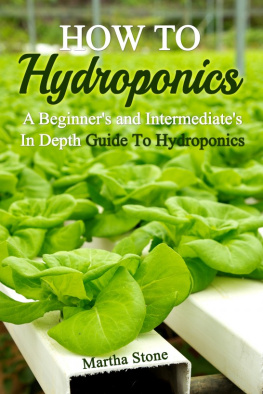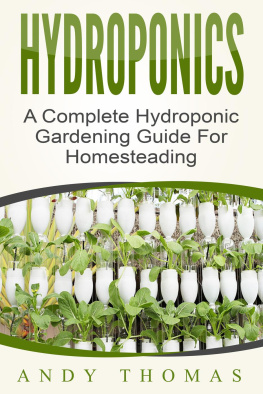Simple Guide on HydroponicsGardening
Expert Tips for Beginners and Intermediate Gardeners
By Martha Stone
Copyright 2014 MarthaStone
Smashwords Edition
Smashwords Edition,License Notes
This ebook is licensed for your personalenjoyment only. This ebook may not be re-sold or given away toother people. If you would like to share this book with anotherperson, please purchase an additional copy for each recipient. Ifyoure reading this book and did not purchase it, or it was notpurchased for your use only, then please return to your favoriteebook retailer and purchase your own copy. Thank you for respectingthe hard work of this author.
Table of Contents
Chapter 1: Introductionto Hydroponics
When people talk about gardening and growing greens, the first fewthings that come to mind are soil and dirt. Traditionally, plantingmeans growing seeds with the use of soil. However, thank heavensfor science, hydroponics was discovered.
Hydroponics is a way of gardening with theuse of nutrition and water mixture to compensate for what the soilcan essentially do in the growing process. It is as efficient astraditional planting and offers less risk of diseases that may beacquired through soil. Because of its advantages and convenience,it became really popular among gardening enthusiasts.
Benefits ofHydroponics
Hydroponics became popular for variousreasons. One of the most evident advantage of hydroponics gardeningis that soil is not required. This means there is minimal to nodirt in the whole planting process. In addition, money spent onpesticides and fertilizers may now be omitted on your gardeningbudget. So much of your time may also be saved because there is noneed to weed and till your plants.
Cultivation via hydroponics allows you togrow plants any month of the year because it may be done indoors.This enables you to have control over various gardening aspectssuch as the amount of water and light. You may also protect yourcrops from the weather and the possibility for pest control is veryhigh.
Setting up your own garden using hydroponicsis easy. As soon as you decide on the location of where you want togrow your crops, you may focus on building your own greenhouse.Choose what kind of plants to cultivate and research about thenutrients that it needs. Materials with relative information aboutplants and hydroponics are available almost everywhere. Take thetime to know and understand how it works to ensure youll get yourexpected results. You may also ask around and participate in forumsas there are thousands of gardening enthusiasts who are now intohydroponics. Since most of them are experienced, you can ask fortips and other information that you may need as a beginner.
Chapter 2: Setting UpYour Own Hydroponics Garden
Hydroponics is a method used by gardening enthusiasts to grow cropswithout using soil. A lot of people are fascinated in its processbecause not only is it effective in cultivating plants, but alsosetting it up is very easy. There are so many advantages inchoosing hydroponics gardening than the traditional plant growing.Hydroponics will save you space, time, energy and money. The basicsin hydroponics are easy to learn and it has in fact been practicedfor decades. All you need is the step by step instruction and youare on your way to setting up your very own greenhouse.
How to Grow PlantsUsing Hydroponics System
The first thing that you need to know is howhydroponics works. Everyone was taught that one of the maincomponents of planting is soil. Who would have thought thateliminating it in the planting process is possible? Heres how.
Plant cultivation with the use of hydroponicsmay be done in two ways active or passive. Active hydroponicsrequires a nutrient solution which will be passed on to the plantsroots. This method typically needs a big planting medium to createthe system for one crop. Passive hydroponics, on the other hand,involves a wick system or a capillary that will distribute thenutrient mixture to the plants roots. Although it is seldom used,some people consider this process easier to set up than activehydroponics.
How to Setup an ActiveHydroponics System
The materials needed include:
planting pot that has holes meant fordrainage (1 gallon)
buckets with no holes which will be used as acontainer for the nutrient solution (2 gallons)
water pump that will be used for the nutrientmixture
plastic tubes with length that canaccommodate the pot to the water pump and the water pump to thecontainer of the nutrient mixture
pins to connect and keep the tubes inplace
small bag of either pea gravel orvermiculite
a timer connected to the water pump whichwill serve as a water controller
a small table wherein the pot will beplaced
First, the table where you will place theplanting pot should have a small hole with the size of your pot butmake sure that it wont fall through and that the pot is securednot to move in any way. Place the planting pot on that hole andfill the pot with either pea gravel or vermiculite leaving at leastan inch or two. Get the bucket with no holes or the reservoir andplace it directly below the drainage holes on the planting pot. Setup the water pump near the reservoir and connect the two plastictubes. Attach one tube to the water pump and connect the other endon the reservoir then use the other tube to connect the plantingpot and the water pump. The tube on the reservoir that is connectedto the water pump must be placed at the bottom so that the nutrientmixture will be properly distributed while the one connected to theplanting pot must be on the rim of the bucket. In addition, inconnecting the tube on the planting pot, make sure that it isplaced above the pea gravel or vermiculite, whichever medium youchoose.
Once you are done with the setup, you may nowtest whether it works properly. Turn the water pump on and checkwhether the tubes are correctly attached. Monitor whether there areleaks and if there are any, fix it right away. After testing, youmay now place the plant on the pot and make the nutrient mixturethat will be placed on the bucket below the planting pot or whatwas called earlier as the reservoir.
How to Setup anInactive Hydroponics System
The things you need to setup an inactivehydroponic system are:
planting pot (1 gallon) with holes that willbe used for drainage
a wick that will be used to absorb thenutrient solution
a small table where the planting pot will beplaced
small bag of either sand or sawdust
a bucket without holes which will be used asa container for the nutrient mixture
First, the table where you will place theplanting pot should have a small hole with the size of your pot butmake sure that it wont fall through and that the pot is securednot to move in any way. Place the planting pot on that hole. Getthe wick that will be used for hydroponics absorption and put it onthe growing pot. The wick must be placed on the pots wall all theway through the holes. Make sure that the wick reaches thereservoir to allow the absorption of the nutrient solution. Fillthe pot with either sand or sawdust leaving at least an inch ortwo. Get the bucket with no holes or the reservoir and place itdirectly below the drainage holes on the planting pot. Put the wickon the reservoir. Make sure that it will be submerged properly onceyou put water or nutrient mixture on the bucket.
When you are finished with the setup, you maynow test whether it works or not. Put water on the reservoir andwait for 30 minutes to 1 hour. Touch the sand or sawdust, whichevermedium you chose. It should be moist by then. Lastly, put yourchosen plant and the nutrient solution.
Next page














